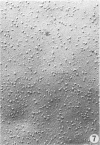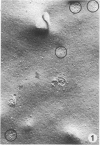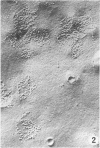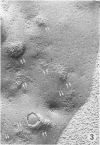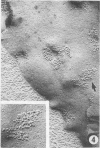Abstract
Frog urinary bladder epithelium has been examined by freeze-fracture electron microscopy of preparations previously fixed by glutaraldehyde either at rest or during antidiuretic challenge. All the agonists tested were observed to induce membrane particle clustering in the A face of the apical plasma membrane of granular cells. This was the case for the natural hormone (hypophysical extracts) and its presumed cellular mediator, adenosine 3',5'-monophosphate. Particle clustering was observed both in the presence and in the absence of water net flow and is thus independent of these movements. Clusters were also observed during hydrosmotic challenge by hypertonic serosal media, a condition which depresses transepithelial sodium transport. No complementary patterns of these A face clusters could be found on the B face. The significance of these membrane-associated particle clusters is discussed in terms of membrane structure and function.
Full text
PDF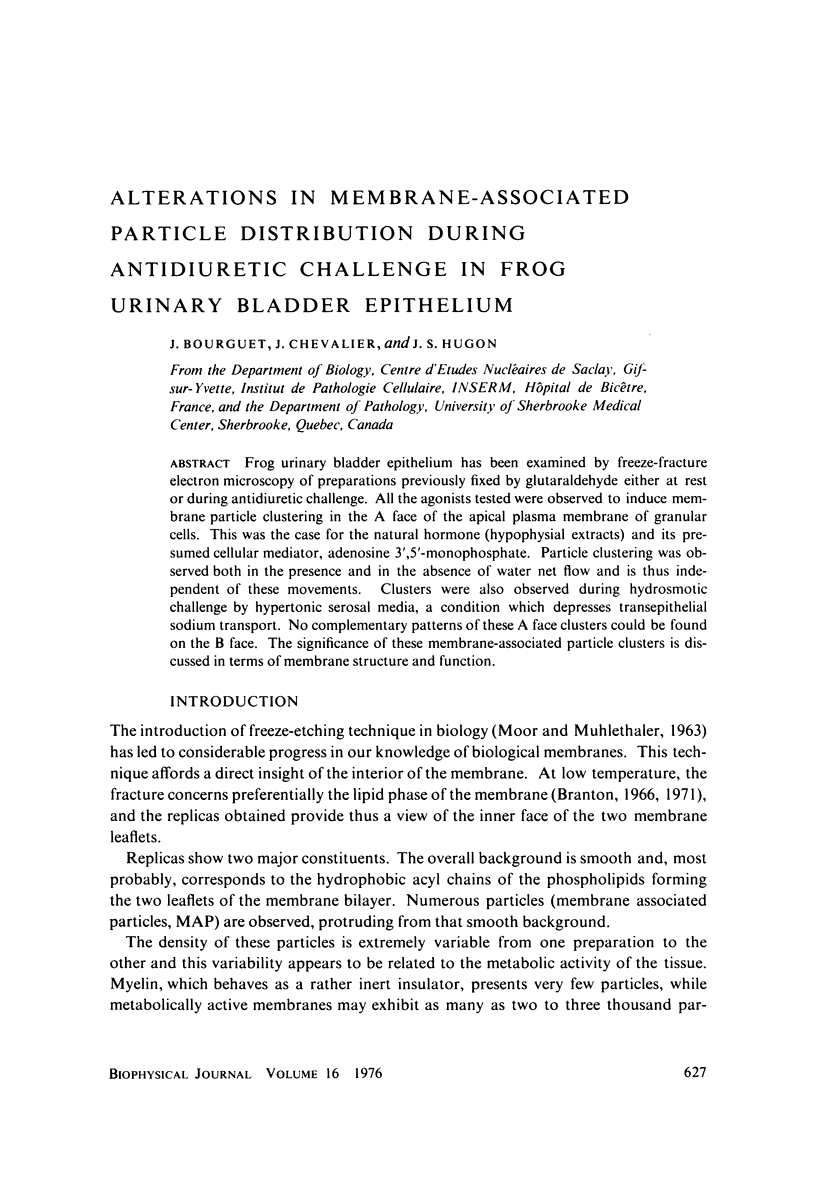





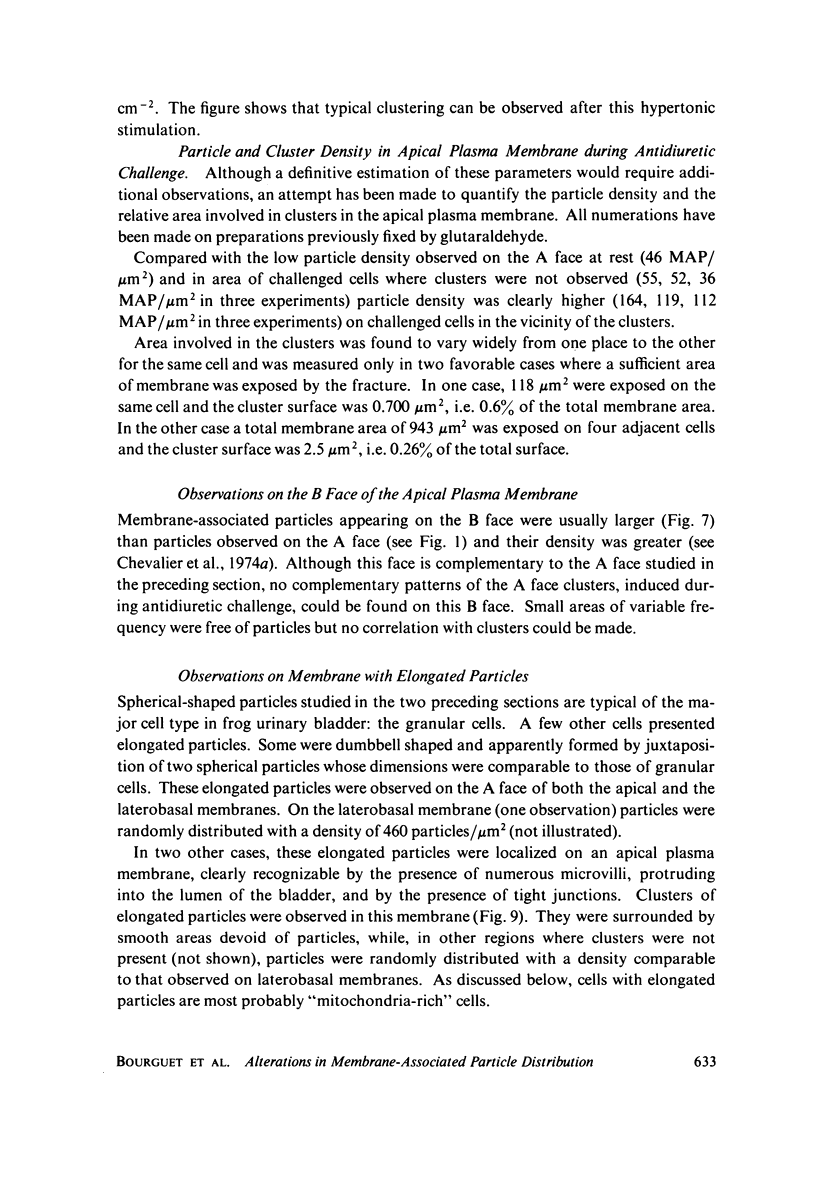






Images in this article
Selected References
These references are in PubMed. This may not be the complete list of references from this article.
- Ahkong Q. F., Fisher D., Tampion W., Lucy J. A. Mechanisms of cell fusion. Nature. 1975 Jan 17;253(5488):194–195. doi: 10.1038/253194a0. [DOI] [PubMed] [Google Scholar]
- BENTLEY P. J. PHYSIOLOGICAL PROPERTIES OF THE ISOLATED FROG BLADDER IN HYPEROSMOTIC SOLUTIONS. Comp Biochem Physiol. 1964 Jun;12:233–239. doi: 10.1016/0010-406x(64)90177-x. [DOI] [PubMed] [Google Scholar]
- BENTLEY P. J. The effects of neurohypophysial extracts on the water transfer across the wall of the isolated urinary bladder of the toad Bufo marinus. J Endocrinol. 1958 Sep;17(3):201–209. doi: 10.1677/joe.0.0170201. [DOI] [PubMed] [Google Scholar]
- BOURGUET J., JARD S. UN DISPOSITIF AUTOMATIQUE DE MESURE ET D'ENREGISTREMENT DU FLUX NET D'EAU 'A TRAVERS LA PEAU ET LA VESSIE DES AMPHIBIENS. Biochim Biophys Acta. 1964 Sep 25;88:442–444. [PubMed] [Google Scholar]
- Branton D. Fracture faces of frozen membranes. Proc Natl Acad Sci U S A. 1966 May;55(5):1048–1056. doi: 10.1073/pnas.55.5.1048. [DOI] [PMC free article] [PubMed] [Google Scholar]
- Branton D. Freeze-etching studies of membrane structure. Philos Trans R Soc Lond B Biol Sci. 1971 May 27;261(837):133–138. doi: 10.1098/rstb.1971.0043. [DOI] [PubMed] [Google Scholar]
- Bretscher M. S. Phosphatidyl-ethanolamine: differential labelling in intact cells and cell ghosts of human erythrocytes by a membrane-impermeable reagent. J Mol Biol. 1972 Nov 28;71(3):523–528. doi: 10.1016/s0022-2836(72)80020-2. [DOI] [PubMed] [Google Scholar]
- Chevalier J., Bourguet J., Hugon J. S. Membrane associated particles: distribution in frog urinary bladder epithelium at rest and after oxytocin treatment. Cell Tissue Res. 1974;152(2):129–140. doi: 10.1007/BF00224690. [DOI] [PubMed] [Google Scholar]
- Chevalier J., Ripoche P., Pisam M., Bourguet J., Hugon J. S. A time course study of water permeability and morphological alterations induced by mucosal hyperosmolarity in frog urinary bladder. Cell Tissue Res. 1974;154(3):345–356. doi: 10.1007/BF00223731. [DOI] [PubMed] [Google Scholar]
- Claude P., Goodenough D. A. Fracture faces of zonulae occludentes from "tight" and "leaky" epithelia. J Cell Biol. 1973 Aug;58(2):390–400. doi: 10.1083/jcb.58.2.390. [DOI] [PMC free article] [PubMed] [Google Scholar]
- De Camilli P., Peluchetti D., Meldolesi J. Structural difference between luminal and lateral plasmalemma in pancreatic acinar cells. Nature. 1974 Mar 15;248(445):245–247. doi: 10.1038/248245b0. [DOI] [PubMed] [Google Scholar]
- Dempsey G. P., Bullivant S., Watkins W. B. Endothelial cell membranes: polarity of particles as seen by freeze-fracturing. Science. 1973 Jan 12;179(4069):190–192. doi: 10.1126/science.179.4069.190. [DOI] [PubMed] [Google Scholar]
- Friend D. S., Fawcett D. W. Membrane differentiations in freeze-fractured mammalian sperm. J Cell Biol. 1974 Nov;63(2 Pt 1):641–664. doi: 10.1083/jcb.63.2.641. [DOI] [PMC free article] [PubMed] [Google Scholar]
- Gilula N. B., Satir P. The ciliary necklace. A ciliary membrane specialization. J Cell Biol. 1972 May;53(2):494–509. doi: 10.1083/jcb.53.2.494. [DOI] [PMC free article] [PubMed] [Google Scholar]
- Kyte J. The reactions of sodium and potassium ion-activated adenosine triphosphatase with specific antibodies. Implications for the mechanism of active transport. J Biol Chem. 1974 Jun 10;249(11):3652–3660. [PubMed] [Google Scholar]
- Leaf A. Transepithelial transport and its hormonal control in toad bladder. Ergeb Physiol. 1965;56:216–263. [PubMed] [Google Scholar]
- Loewenstein W. R. On the genesis of cellular communication. Dev Biol. 1967 Jun;15(6):503–520. doi: 10.1016/0012-1606(67)90050-4. [DOI] [PubMed] [Google Scholar]
- Nicolson G. L., Singer S. J. Ferritin-conjugated plant agglutinins as specific saccharide stains for electron microscopy: application to saccharides bound to cell membranes. Proc Natl Acad Sci U S A. 1971 May;68(5):942–945. doi: 10.1073/pnas.68.5.942. [DOI] [PMC free article] [PubMed] [Google Scholar]
- Orci L., Perrelet A. Membrane-associated particles: increase at sites of pinocytosis demonstrated by freeze-etching. Science. 1973 Aug 31;181(4102):868–869. doi: 10.1126/science.181.4102.868. [DOI] [PubMed] [Google Scholar]
- Orloff J., Handler J. The role of adenosine 3',5'-phosphate in the action of antidiuretic hormone. Am J Med. 1967 May;42(5):757–768. doi: 10.1016/0002-9343(67)90093-9. [DOI] [PubMed] [Google Scholar]
- Pinto da Silva P. Membrane intercalated particles in human erythrocyte ghosts: sites of preferred passage of water molecules at low temperature. Proc Natl Acad Sci U S A. 1973 May;70(5):1339–1343. doi: 10.1073/pnas.70.5.1339. [DOI] [PMC free article] [PubMed] [Google Scholar]
- Ripoche P., Pisam M. Ultrastructural modifications of frog urinary bladder epithelium under the influence of hypertonic media. Z Zellforsch Mikrosk Anat. 1973 Feb 9;137(1):13–19. doi: 10.1007/BF00307046. [DOI] [PubMed] [Google Scholar]
- SAWYER W. H., SCHISGALL R. M. Increased permeability of the frog bladder to water in response to dehydration and neurohypophysial extracts. Am J Physiol. 1956 Nov;187(2):312–314. doi: 10.1152/ajplegacy.1956.187.2.312. [DOI] [PubMed] [Google Scholar]
- Satir P., Gilula N. B. The fine structure of membranes and intercellular communication in insects. Annu Rev Entomol. 1973;18:143–166. doi: 10.1146/annurev.en.18.010173.001043. [DOI] [PubMed] [Google Scholar]
- Scott W. N., Sapirstein V. S., Yoder M. J. Partition of tissue functions in epithelia: localization of enzymes in "mitochondria-rich" cells of toad urinary bladder. Science. 1974 May 17;184(4138):797–800. doi: 10.1126/science.184.4138.797. [DOI] [PubMed] [Google Scholar]
- Singer S. J. The molecular organization of membranes. Annu Rev Biochem. 1974;43(0):805–833. doi: 10.1146/annurev.bi.43.070174.004105. [DOI] [PubMed] [Google Scholar]
- Staehelin L. A. Structure and function of intercellular junctions. Int Rev Cytol. 1974;39:191–283. doi: 10.1016/s0074-7696(08)60940-7. [DOI] [PubMed] [Google Scholar]
- Wade J. B., DiScala V. A., Karnovsky M. J. Membrane structural specialization of the toad urinary bladder revealed by the freeze-fracture technique. I. The granular cell. J Membr Biol. 1975 Jul 24;22(3-4):385–402. doi: 10.1007/BF01868182. [DOI] [PubMed] [Google Scholar]
- Wade J. B., Revel J. P., DiScala V. A. Effect of osmotic gradients on intercellular junctions of the toad bladder. Am J Physiol. 1973 Feb;224(2):407–415. doi: 10.1152/ajplegacy.1973.224.2.407. [DOI] [PubMed] [Google Scholar]




